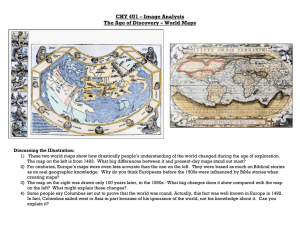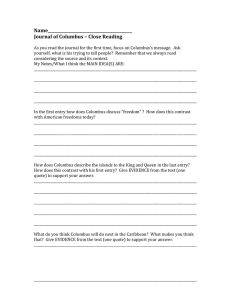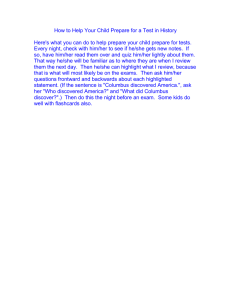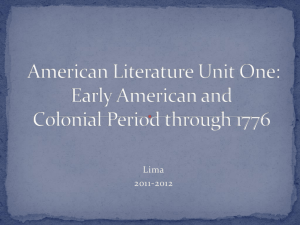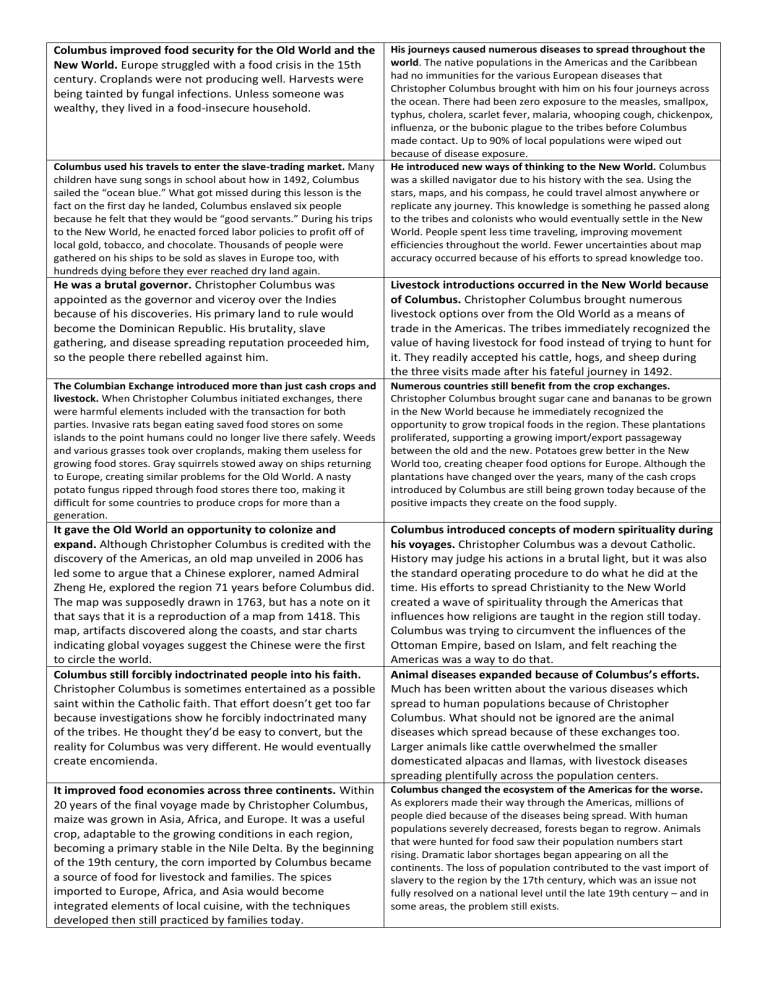
Columbus improved food security for the Old World and the New World. Europe struggled with a food crisis in the 15th century. Croplands were not producing well. Harvests were being tainted by fungal infections. Unless someone was wealthy, they lived in a food-insecure household. Columbus used his travels to enter the slave-trading market. Many children have sung songs in school about how in 1492, Columbus sailed the “ocean blue.” What got missed during this lesson is the fact on the first day he landed, Columbus enslaved six people because he felt that they would be “good servants.” During his trips to the New World, he enacted forced labor policies to profit off of local gold, tobacco, and chocolate. Thousands of people were gathered on his ships to be sold as slaves in Europe too, with hundreds dying before they ever reached dry land again. His journeys caused numerous diseases to spread throughout the world. The native populations in the Americas and the Caribbean had no immunities for the various European diseases that Christopher Columbus brought with him on his four journeys across the ocean. There had been zero exposure to the measles, smallpox, typhus, cholera, scarlet fever, malaria, whooping cough, chickenpox, influenza, or the bubonic plague to the tribes before Columbus made contact. Up to 90% of local populations were wiped out because of disease exposure. He introduced new ways of thinking to the New World. Columbus was a skilled navigator due to his history with the sea. Using the stars, maps, and his compass, he could travel almost anywhere or replicate any journey. This knowledge is something he passed along to the tribes and colonists who would eventually settle in the New World. People spent less time traveling, improving movement efficiencies throughout the world. Fewer uncertainties about map accuracy occurred because of his efforts to spread knowledge too. He was a brutal governor. Christopher Columbus was appointed as the governor and viceroy over the Indies because of his discoveries. His primary land to rule would become the Dominican Republic. His brutality, slave gathering, and disease spreading reputation proceeded him, so the people there rebelled against him. Livestock introductions occurred in the New World because of Columbus. Christopher Columbus brought numerous livestock options over from the Old World as a means of trade in the Americas. The tribes immediately recognized the value of having livestock for food instead of trying to hunt for it. They readily accepted his cattle, hogs, and sheep during the three visits made after his fateful journey in 1492. The Columbian Exchange introduced more than just cash crops and livestock. When Christopher Columbus initiated exchanges, there were harmful elements included with the transaction for both parties. Invasive rats began eating saved food stores on some islands to the point humans could no longer live there safely. Weeds and various grasses took over croplands, making them useless for growing food stores. Gray squirrels stowed away on ships returning to Europe, creating similar problems for the Old World. A nasty potato fungus ripped through food stores there too, making it difficult for some countries to produce crops for more than a generation. Numerous countries still benefit from the crop exchanges. Christopher Columbus brought sugar cane and bananas to be grown in the New World because he immediately recognized the opportunity to grow tropical foods in the region. These plantations proliferated, supporting a growing import/export passageway between the old and the new. Potatoes grew better in the New World too, creating cheaper food options for Europe. Although the plantations have changed over the years, many of the cash crops introduced by Columbus are still being grown today because of the positive impacts they create on the food supply. It gave the Old World an opportunity to colonize and expand. Although Christopher Columbus is credited with the discovery of the Americas, an old map unveiled in 2006 has led some to argue that a Chinese explorer, named Admiral Zheng He, explored the region 71 years before Columbus did. The map was supposedly drawn in 1763, but has a note on it that says that it is a reproduction of a map from 1418. This map, artifacts discovered along the coasts, and star charts indicating global voyages suggest the Chinese were the first to circle the world. Columbus still forcibly indoctrinated people into his faith. Christopher Columbus is sometimes entertained as a possible saint within the Catholic faith. That effort doesn’t get too far because investigations show he forcibly indoctrinated many of the tribes. He thought they’d be easy to convert, but the reality for Columbus was very different. He would eventually create encomienda. Columbus introduced concepts of modern spirituality during his voyages. Christopher Columbus was a devout Catholic. History may judge his actions in a brutal light, but it was also the standard operating procedure to do what he did at the time. His efforts to spread Christianity to the New World created a wave of spirituality through the Americas that influences how religions are taught in the region still today. Columbus was trying to circumvent the influences of the Ottoman Empire, based on Islam, and felt reaching the Americas was a way to do that. Animal diseases expanded because of Columbus’s efforts. Much has been written about the various diseases which spread to human populations because of Christopher Columbus. What should not be ignored are the animal diseases which spread because of these exchanges too. Larger animals like cattle overwhelmed the smaller domesticated alpacas and llamas, with livestock diseases spreading plentifully across the population centers. It improved food economies across three continents. Within 20 years of the final voyage made by Christopher Columbus, maize was grown in Asia, Africa, and Europe. It was a useful crop, adaptable to the growing conditions in each region, becoming a primary stable in the Nile Delta. By the beginning of the 19th century, the corn imported by Columbus became a source of food for livestock and families. The spices imported to Europe, Africa, and Asia would become integrated elements of local cuisine, with the techniques developed then still practiced by families today. Columbus changed the ecosystem of the Americas for the worse. As explorers made their way through the Americas, millions of people died because of the diseases being spread. With human populations severely decreased, forests began to regrow. Animals that were hunted for food saw their population numbers start rising. Dramatic labor shortages began appearing on all the continents. The loss of population contributed to the vast import of slavery to the region by the 17th century, which was an issue not fully resolved on a national level until the late 19th century – and in some areas, the problem still exists.


